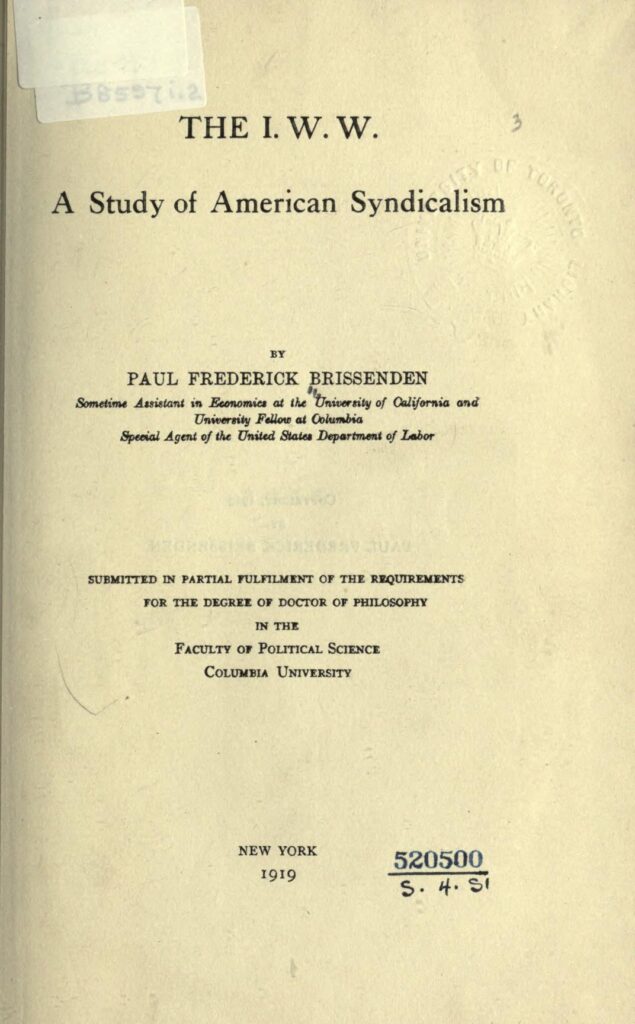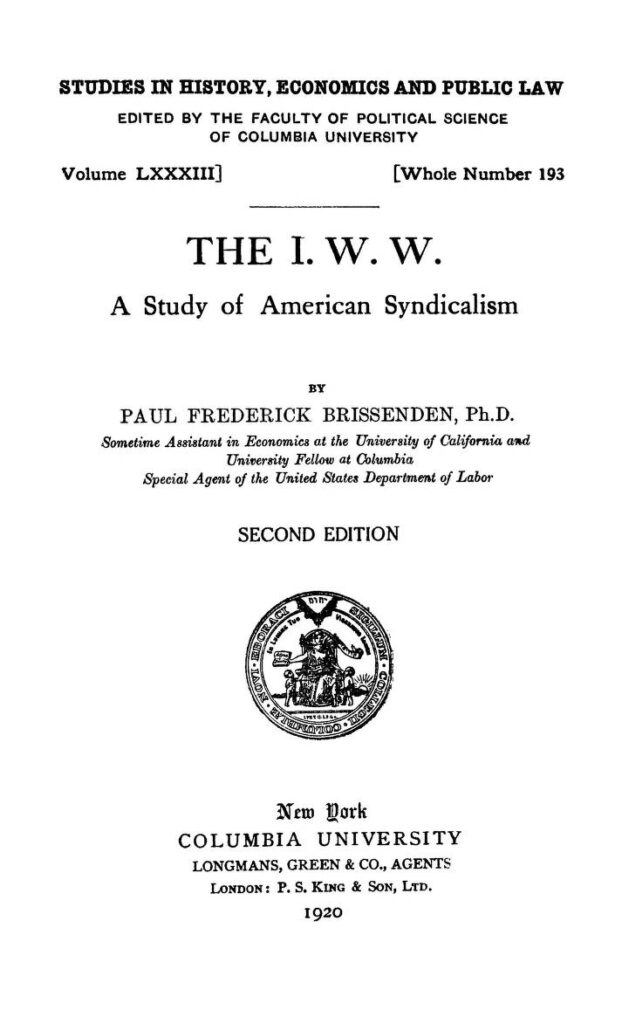Biblioteca / 1910-1919
Paul F. Brissenden. The I.W.W. A Study of American Syndicalism.
Nueva York: Columbia University, 1919. 433 páginas.
2da edición, 1920. 438 páginas.
CONTENTS
PREFACE
PART I
BEGINNINGS
I – FORERUNNERS OF THE «WOBBLIES»
Early revolutionary bodies
English prototypes
Early radical unions in the United States
The National Labor Union
The Knights of Labor
The Internationals
The Sovereigns of Industry
The United Brewery Workmen
The United Mine Workers of America
Haymarket
The American Railway Union
The Western Federation of Miners
W. F. M. strikes
The Western Labor Union
The American Labor Union
The Socialist Labor Party and the Socialist Trade and Labor Alliance
The French Confédération Général du Travail
II – THE BIRTH OF THE I. W. W.
Pre-convention conferences
The rôle of the Western Federation of Miners
The January Conference
The Industrialist Manifesto
Attitude of the A. F. of L.
The Industrial Union Convention and the launching of the I. W. W.
Character of industries and unions represented
Numerical predominance of the Western Federation and the American Labor Union
Daniel DeLeon and the Socialist Trade and Labor Alliance
Doctrinal elements represented in the convention: reformist, direct-actionist and doctrinaire
The dominant personalities
III – THE I. W. W. versus THE A. F. OF L.
Attitude of the revolutionary industrialists toward the Federation
Critique of craft unionism
“Union scabbery” and the aristocracy of labor
Emphasis on the unskilled and unorganized
The “pure and simple” union and the “labor lieutenant”
Repudiation of the policy of “boring from within”
Convention resolutions
The preamble and the clause on political action
The attitude of DeLeon and the S. L. P.
The I. W. W. Constitution
Classification of industries
The structure of the organization
The local unions and other subordinate bodies
The General Executive Board and its powers
Other provisions
Influence of “DeLeonism” in the convention
The primary importance of the Western Federation of Miners
Samuel Gompers on the convention
Other comments
What the constitutional convention accomplished
PART II
THE FIRST PHASE
[The «original» I. W. W.]
IV – MAIDEN EFFORTS ON THE ECONOMIC FIELD
The situation at the close of the first convention
Progress during the first year
Activities among A. F. of L. locals
Friction with Federation unions
Practical compromises with the craft-union idea
Internal dissension
Breakdown of the Metals and Machinery Department
Defection of the Western Federation of Miners
Early strikes and strike activities
Strike policies
The New Jersey Socialist Unity Conference
The discussion on socialism and the trade unions
The Unity Conference resolutions
The second I. W. W. convention
Growth in membership
The Industrial Departments
V – THE coup OF THE «PROLETARIAN RABBLE»
The «reactionaries» vs. the «wage slave delegates» at the second convention
The DeLeon-St. John attack on President Sherman
Pre-convention conference of the «DeLeonite rabble»
The indictment of Sherman
Playing freeze-out with the «wage slave delegates»
The per diem resolution and the defeat of the Shermanites
Abolition of the office of General President
The findings of the Master in Chancery
Contemporary comment on the quarrel
DeLeonism and the Socialist Labor Party at the second convention
The Western Federation of Miners
I. W. W. finances
VI – THE STRUCTURE OF A MILITANT UNION
An organization for farm laborers and city proletarians
The I. W. W. and the lumber workers
Provision for foreigners
Foreign language branches
The local union
Relation of locals to the General Administration
Centralization
District Industrial Councils
Industrial Departments
Further discussion of political action
The Moyer, Hay wood and Pettibone case 170
Defense activities of the I. W. W.
Proposal for a general strike
Effect of the Moyer-Haywood case on the I. W. W.
VII – THE FIGHT FOR EXISTENCE
The third convention
The condition of the organization
Membership strength
The I. W. W. at the Stuttgart Congress
Political parties and the trade unions
The political clause of the Preamble again under discussion
VIII – «JOB CONTROL» AT GOLDFIELD
The A. F. of L. and the I. W. W. in Goldfield, Nevada
Character of the Goldfield local of the I. W. W.
The town unionists and the mine unionists
Proposed consolidation of the two groups
Attitude of the Mine Owners’ Association
Federal military intervention and investigation
Report of the Commission
What the I. W. W. accomplished at Goldfield
The I. W. W. and the Western Federation in Nevada politics
I. W. W. strike activities in other parts of the country
General organizing activities
IX – DOCTRINAIRE versus DIRECT-ACTIONIST
Condition of the organization on the eve of the schism of 1908
Effect of the financial panic of 1907
The widening breach between the I. W. W. and the Western Federation of Miners
The line-up in the I. W. W. on political action
The personnel of the convention
Walsh’s «Overalls Brigade»
The Socialist Labor Party Delegation and the unseating of Daniel DeLeon
The issue between the DeLeonites and the Direct-actionists
“Straight industrialism” versus parliamentarianism
The preamble purged of politics
Rump convention of the DeLeonites at Paterson, New Jersey
A bifurcated I. W. W.
The issue between the Detroit I. W. W. and the Chicago I. W. W.
The Wobblies’ criticism of parliamentary government
The doctrinaire state socialism of the Detroiters
The issue illustrated in the contrast between Daniel DeLeon and Vincent St. John
I. W. W. constitution non-political rather than anti-political
Influence of DeLeon on the I. W. W.
X – THE I. W. W. ON THE «CIVILIZED PLANE»
The development of the Detroit I. W. W.
Strike activities and friction with the «Summery» or Direct-actionist faction
The Anarcho-syndicalists versus the parliamentarians
The Detroit I. W. W. on sabotage
Eugene Debs’ plea for a union of the two I. W. W.s
The Detroit I. W. W. becomes The Workers International Industrial Union
PART III
THE ANARCHO-SYNDICALISTS
[The Direct Actionists]
XI – FREE SPEECH AND Sabotage
Condition of the Direct-actionist faction after the split with the Doctrinaires
The Wobblies establish the «free-speech fight» as an institution
The procedure in free-speech fights
I. W. W. tactics
Community reactions
The conventions of 1910 and 1911
Growth in membership
The I. W. W. press
Local unions organized and disbanded
The I. W. W. and the French syndicalists
International labor politics
The Syndicalist League of North America
The I. W. W. and the MacNamara case
Franco-American sabotage
Demonstration against sabotage at the 1912 convention of the Socialist party
Article II., section 6
XII – LAWRENCE AND THE CREST OF POWER
Strike activities in 1912
The Lawrence strike
The use of violence at Lawrence and the responsibility for it
Dynamite planting
The I. W. W. and the A. F. of L. at Lawrence
Results of the strike
I. W. W. patriotism and I. W. W. morals
The 1912 convention
The beginning of the conflict over decentralization
XIII – DUAL UNIONISM AND DECENTRALIZATION
The policy of «boring from within»
Dual unionism
An I. W. W. defense of «boring from within»
Tom Mann joins in the attack on dual unionism
Rejoinders from Ettor and Haywood
The 1913 convention
Centralization versus decentralization
The proposals of the «decentralizes»
The relation of the locals to the general organization
The Pacific Coast District Organization
The East against the West in the decentralization debate
The western Wobbly and the eastern
Geographical differences in I. W. W. local unions
An anarchist’s impressions of the 1913 convention
XIV – RECENT TENDENCIES
Continued hostility between the I. W. W. and the Western Federation of Miners
The labor war in Butte, Montana
The United Mine Workers and the I. W. W.
The 1914 convention
The I. W. W. and the unemployed
The resolution against war
Constitutional changes
Time agreements
Growth in membership
The slump in 1914-1915
Revival of activity
The Agricultural Workers Organization
The Everett free speech fight
The 1916 (tenth) convention
Present strength of the I. W. W.
Character of the membership
The I. W. W. abroad
Anti-militarist campaign of the I. W. W. in Australasia
Australian «Unlawful Associations» Act.
The Workers’ Industrial Union of Australia
«Criminal Syndicalism» laws in the United States
The turnover of I. W. W. members and locals
Conclusion
APPENDICES
I – Chart of early radical labor organizations
II – The I. W. W. Preamble: Chicago and Detroit versions
III – The structure of the organization in 1917. (Chart)
IV – Membership statistics:
Table A. Membership of Chicago and Detroit branches. (1905-1916)
Table B. Membership of the I. W. W. compared with the aggregate number of organized workers in the U. S., by industries
Table C. Membership of the I. W. W. and of certain other selected organizations and industrial groups. (1897-1914)
Table D. Membership of (i) the I. W. W. and (2) all American trade unions
V – Geographical distribution of I. W. W. locals in 1914. (Chicago and Detroit)
VI – Reasons assigned for locals disbanding. (1910-1911)
VII – Free-speech fights of the I. W. W. (1906-1916)
VIII – I. W. W. strikes. (1906-1917)
IX – Selections from the I. W. W. Song Book
X – Copies of State » Criminal Syndicalism» statutes
BIBLIOGRAPHY

